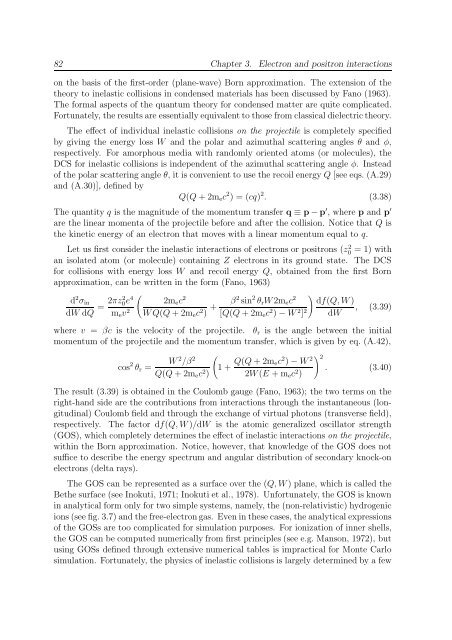PENELOPE 2003 - OECD Nuclear Energy Agency
PENELOPE 2003 - OECD Nuclear Energy Agency
PENELOPE 2003 - OECD Nuclear Energy Agency
You also want an ePaper? Increase the reach of your titles
YUMPU automatically turns print PDFs into web optimized ePapers that Google loves.
82 Chapter 3. Electron and positron interactions<br />
on the basis of the first-order (plane-wave) Born approximation. The extension of the<br />
theory to inelastic collisions in condensed materials has been discussed by Fano (1963).<br />
The formal aspects of the quantum theory for condensed matter are quite complicated.<br />
Fortunately, the results are essentially equivalent to those from classical dielectric theory.<br />
The effect of individual inelastic collisions on the projectile is completely specified<br />
by giving the energy loss W and the polar and azimuthal scattering angles θ and φ,<br />
respectively. For amorphous media with randomly oriented atoms (or molecules), the<br />
DCS for inelastic collisions is independent of the azimuthal scattering angle φ. Instead<br />
of the polar scattering angle θ, it is convenient to use the recoil energy Q [see eqs. (A.29)<br />
and (A.30)], defined by<br />
Q(Q + 2m e c 2 ) = (cq) 2 . (3.38)<br />
The quantity q is the magnitude of the momentum transfer q ≡ p − p ′ , where p and p ′<br />
are the linear momenta of the projectile before and after the collision. Notice that Q is<br />
the kinetic energy of an electron that moves with a linear momentum equal to q.<br />
Let us first consider the inelastic interactions of electrons or positrons (z0 2 = 1) with<br />
an isolated atom (or molecule) containing Z electrons in its ground state. The DCS<br />
for collisions with energy loss W and recoil energy Q, obtained from the first Born<br />
approximation, can be written in the form (Fano, 1963)<br />
d 2 σ in<br />
dW dQ = 2πz2 0e 4 (<br />
2m e c 2<br />
m e v 2 W Q(Q + 2m e c 2 ) + β2 sin 2 θ r W 2m e c 2 )<br />
df(Q, W )<br />
[Q(Q + 2m e c 2 ) − W 2 ] 2 dW , (3.39)<br />
where v = βc is the velocity of the projectile. θ r is the angle between the initial<br />
momentum of the projectile and the momentum transfer, which is given by eq. (A.42),<br />
cos 2 θ r =<br />
W 2 /β 2 (<br />
1 + Q(Q + 2m ec 2 ) − W 2 ) 2<br />
. (3.40)<br />
Q(Q + 2m e c 2 ) 2W (E + m e c 2 )<br />
The result (3.39) is obtained in the Coulomb gauge (Fano, 1963); the two terms on the<br />
right-hand side are the contributions from interactions through the instantaneous (longitudinal)<br />
Coulomb field and through the exchange of virtual photons (transverse field),<br />
respectively. The factor df(Q, W )/dW is the atomic generalized oscillator strength<br />
(GOS), which completely determines the effect of inelastic interactions on the projectile,<br />
within the Born approximation. Notice, however, that knowledge of the GOS does not<br />
suffice to describe the energy spectrum and angular distribution of secondary knock-on<br />
electrons (delta rays).<br />
The GOS can be represented as a surface over the (Q, W ) plane, which is called the<br />
Bethe surface (see Inokuti, 1971; Inokuti et al., 1978). Unfortunately, the GOS is known<br />
in analytical form only for two simple systems, namely, the (non-relativistic) hydrogenic<br />
ions (see fig. 3.7) and the free-electron gas. Even in these cases, the analytical expressions<br />
of the GOSs are too complicated for simulation purposes. For ionization of inner shells,<br />
the GOS can be computed numerically from first principles (see e.g. Manson, 1972), but<br />
using GOSs defined through extensive numerical tables is impractical for Monte Carlo<br />
simulation. Fortunately, the physics of inelastic collisions is largely determined by a few
















